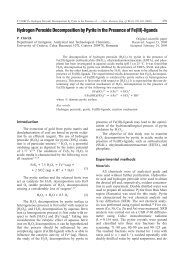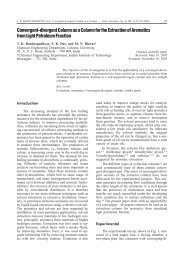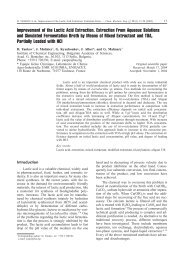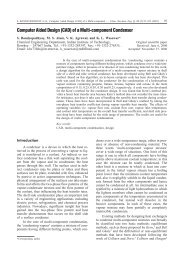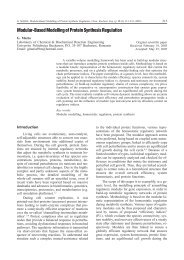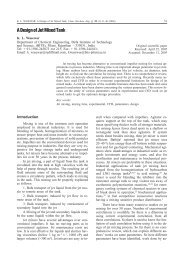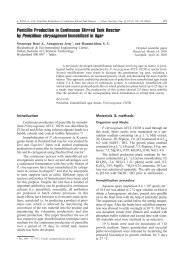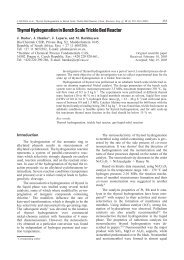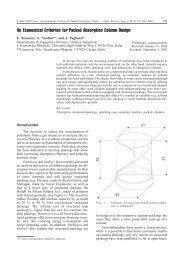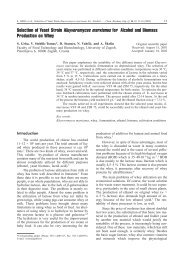Solid State Fermentation: An Overview - pierre
Solid State Fermentation: An Overview - pierre
Solid State Fermentation: An Overview - pierre
Create successful ePaper yourself
Turn your PDF publications into a flip-book with our unique Google optimized e-Paper software.
64 S. BHARGAV et al., <strong>Solid</strong>-state <strong>Fermentation</strong>: <strong>An</strong> <strong>Overview</strong>, Chem. Biochem. Eng. Q. 22 (1) 49–70 (2008)fermentation are shear forces, increase in viscositydue to metabolite secretion, fungal morphology,and reduction in metabolite stability.Gibberellic acidsGibberellic acid is a fungal secondary metaboliteproduced in its stationary phase. The SSF systemnot only minimizes production and extractioncosts, but also increases the yield of gibberellic acids.Accumulation of gibberellic acid was 1.626times higher in SSF than SMF using wheat bran assubstrate with Gibberella fujikuroi P3. 147 Limitationin nitrogen sources stops the exponential growth offungus triggering production of secondary metabolitessuch as gibberellins. 148Various bioreactors using different substrateshave been used for production of gibberellic acid inSSF. Bendelier et al. developed an aseptic pilotscale reactor for production of gibberellic acid usingGibberella fujikoroi in fed batch SSF. 149 Gelmiet al. used amberlite as inert solid support in glasscolumn reactors under different conditions of temperatureand water activity for gibberellic acid production.148 A model using maize cob particlessoaked in an amylaceous effluent was developedfor studying factors affecting gibberellic acid productionin SSF. The factors were particle diameter,volume of liquid phase and substrate concentration.150 Tomasini et al. produced gibberellic acid ondifferent SSF systems such as cassava flour, sugarcanebagasse, and polyurethane foam. With SSF250 mg of gibberellin per kg of dry solid mediumwas produced in 36 h on cassava, but 23 mg ofgibberellin per L of the medium was produced insubmerged fermentation. 151 Scaling up and optimizingthe operation of solid-state cultivation bioreactorswill be simplified if there is availability ofaccurate process models, but problems may still existdue to absence of online measuring devices. 47Aroma productionMicroorganisms play an important role in generationof natural compounds, such as fruity aroma.Although bacteria, yeast and fungi produce aromacompounds only a few spp. of yeast and fungi havebeen preferred due to their GRSA (Generally Regardedas Safe) status. <strong>Solid</strong>-state fermentation hasbeen used for production of aromas by cultivatingNeurospora spp, Zygosaccharomyces rouxii, Aspergillusspp. and Trichoderma viride using pre-gelatinizedrice, miso, cellulose fibers, and agar.Medeiros et al. usedKluyveromyces marxianuson cassava bagasse, as substrate in packed bed reactorwith forced aeration at two different flow rates ofQ = 0.06 and 0.12 L h –1 g –1 . However, with loweraeration, the total volatile content increased at t =24 hbut with higher aeration the total volatile content wasless, and the rate of production decreased. Acetaldehyde,ethyl acetate and ethanol were the three majorvolatile compounds. Production of acetaldehydeand ethyl acetate decreased with increase in aerationrate. This has been attributed to the decrease in vaporpressure within the fermented medium with the increaseof the aeration rate. 152 Strain of Kluyveromycesmarxiamus was cultivated on five differentagro-industrial residues such as cassava bagasse, giantpalm bran, apple pomace, sugarcane bagasse, andsunflower seeds. Palm bran and cassava bagasseproved feasible for aroma production. Ethanol andethyl acetate were in highest concentration withpalm bran and cassava bagasse respectively in t =72h. Difference in composition of fermentation mediumhighly affected the aroma production. 153Ceratocystis fimbriata was used for producingvolatile compounds in column and horizontal drumbioreactors over coffee husk as substrate. However,production was higher in the horizontal drumbioreactor. The dominant compounds in the processwere ethyl acetate, acetaldehyde and ethanol. Thesewere extracted by using porous absorbents. Resinslike (Tenax and Amberlite) showed the best resultsfor volatile compounds. In the case of Tenax,acetaldehyde was recovered in significant amounts(n = 649.7 mol). The type of reactor used and absorbentinfluences the production. 154 Ceratocystisfimbriata when grown on different agro-industrialresidues medium containing cassava bagasse, applepomace, amaranth and soybean resulted in aromaproduction. The medium containing amaranth producedpineapple aroma. However, the medium containingcassava bagasse, apple pomace and soybeanresulted in fruity aroma. The aroma produced wasfound to depend on the growth rate of fungus andits respiratory rate. The greater the respiratory activityof fungus the greater is its growth. 155 Hot watertreated coffee husk was used for production ofaroma production by Ceratocystis fimbriata in SSF.Supplementation of glucose, leucine increased thearoma production but an opposite effect was seenby addition of saline solution. 156Ferron et al. reviewed the microbial prospectsof aroma production using SSF. 157 Longo and Sanromanreviewed the production of aroma compoundsfor the food processing industry by microbial cultures.Production form microorganisms has great advantagesover traditional methods, such as decreasein production costs, ease of downstreaming processes,and use of cheaper agro-industrial substrates. 158A cheap alternative to agro-industrial residuesfor aroma production is cereal grain. Various spp.of Aspergillus,Penicillum,Rhizopus etc, can becultivated on it for production of various aromacompounds such as esters, aldehydes, alcohols etc.



